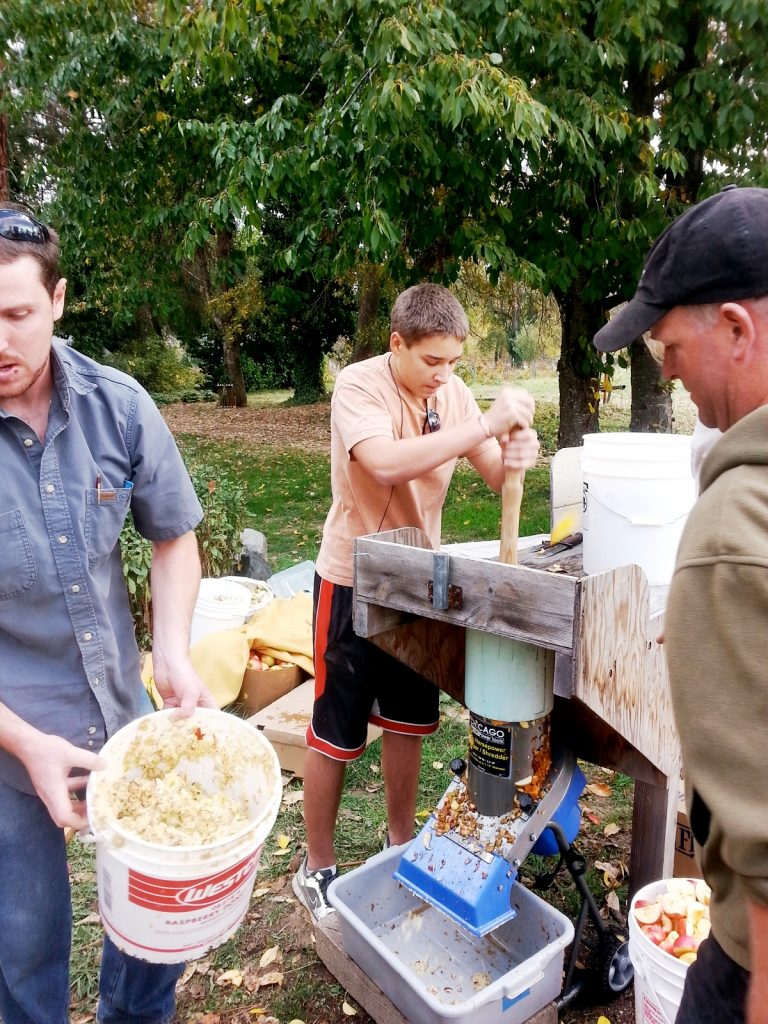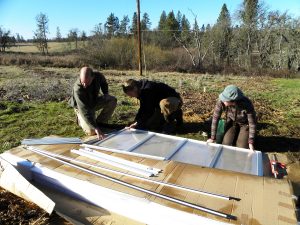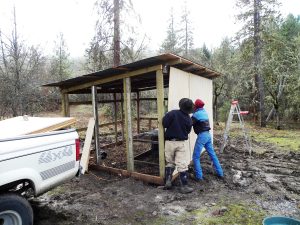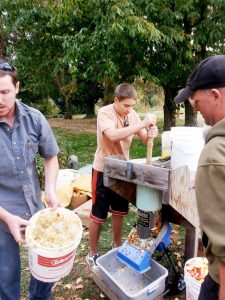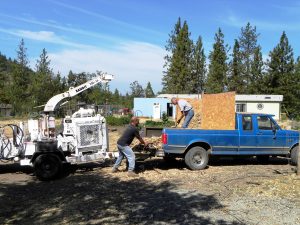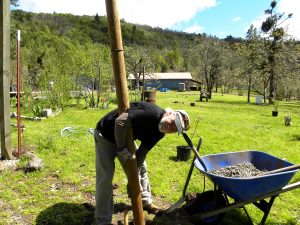By Brie Malarkey
Homesteaders often flee cities to seek independence, yet in many cases it takes a rural village of like-minded neighbors to work land efficiently and economically. Why should any one person or a couple of rural landowners go at it alone simply because they lay claim to the land they occupy? Whether one is a modern homesteader, farmer, or rancher, living independently in a rural setting is exhausting work. Balancing the rural lifestyle coupled with today’s financial demands leaves a great deal of landowners overwhelmed — both fiscally and physically.
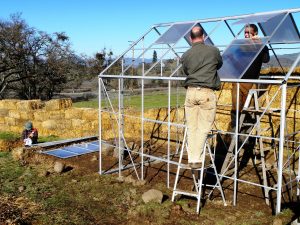
Most homesteaders are engulfed with vision, strategies, and dreams while struggling to find enough resources like time, money, supplies, and more time. “Not enough hours in the day,” you’ll catch many whispering under their breath as they prioritize the daunting list before them. In addition, not all people are capable of all jobs — physically or mentally. After all, it’s hard to wield a chainsaw or pull a field of weeds if you have an aching back!
Loneliness leaves many rural dwellers craving community — rural projects and farm chores often keep owners isolated from other neighbors. A community can help stave off the loneliness. It feels good to bounce ideas off others who have walked (or are walking) the same path.
Community can be found through quilting circles, book clubs, or even barn-raising parties. The noun “barn-raising” is defined as a party in rural areas, usually providing food, drink, etc., for the purpose of assisting a neighbor in putting up a new barn. The origin of the word dates back to 1855, but the objective of barn-raising is timeless. We can still help each other put up barns, till fields, harvest crops, or finish other projects, then relax and play with a community of neighbors. It is a tried and true recipe for a perfect rural life-work balance.
When we decided to create our own work party group, we built off the “barn-raising” idea and called our group “B.A.R.N. (Being Awesome Rural Neighbors) Raisers.” We are based in Jackson County, Oregon, where we help each other raise the standard of our 21st century living by embracing the 19th century practice of barn-raising. We tackle large (or small!) projects together and then sit back and socialize.
Organization is key to starting a work party group. Creating excitement, communicating a vision, and rallying rural neighbors can be daunting even for an outgoing personality. Communication can make or break the success of a work party group.
Starting your B.A.R.N. Raising group
First, identify potential work party members. It’s easy to find like-minded rural neighbors, if you take the time at community events to observe who else is working the land in a similar fashion as yourself. It is recommended you identify neighbors in roughly the same demographic and roughly on the same mission in life, although this isn’t always necessary. Go with your instinct and ask yourself if you’d want to spend an entire day working and socializing with this person and perhaps their partner each month. We operate a small farm with teenagers, so it was important to us when we started our B.A.R.N. Raising group to identify other farmers who didn’t have young kids. We felt we could better relate to them; we were all striving to produce local foods without the burden of a young family. Not only could we help each other with projects, but we could also provide marketing, packaging, and small farm operational advice during our conversations. Perhaps you are not using your land to produce food, but you’re managing a wood lot or simply escaping the city life. You can still find community and potential members for your work party group at church, educational events, local conferences, trade shows, and in local online forums.
Once you’ve identified a few potential neighbors, you have to convince them to join and establish the objectives of the work party group. The bottom line is all humans like clear and concise communication. Luckily barn-raising in the 21st century is easy — not only do we have modern tools, but we also have a wealth of information on the internet, like YouTube “how-to” videos, and amazing communication methods. There’s no need to send your reluctant teenage son out on a three day horseback ride to spread the word of your barn-raising. These days, you can simply set up an email group, utilize event-planning websites, or set up a group page on a social networking site like Facebook. We personally like the Facebook group option as the coordinator can create an “invitation-only” group (not available to the general public) to not only post member contact information and pictures, but manage work party details. Conduct an internet search on setting up a Facebook group for more information.
Once you’ve identified your potential members and established your communication system, you need to know the logistics of your proposed work party (the why, what, who, and where) in order to convince them to join. Spend a little time thinking about what you want to get out of these work parties; after all, you can’t coordinate if you don’t have a vision. Once you’ve established your goals, use that clear and concise communication to sell your neighbors in joining your work party group. As an example I’ve listed my solicitation to join our 2014 B.A.R.N. Raiser group here:
Dear XYZ Farm,
You’ve been invited to join the Jackson County B.A.R.N. Raisers group for 2014. B.A.R.N. stands for Being Awesome Rural Neighbors, because that’s what we’ll become in this group as we support each other through second Sunday ‘barn-raisings’ or work parties at member properties. I would like to find eight (8) farming families to join with me in creating this rural support community to help each other complete daunting projects, network, and share in food & fun! Members (or family) sign up for a second Sunday date between March and October 2014 and host a barn raising work party on their property. Each month, a different member (or family) of the group will be the recipient of the support of the entire group.
By joining this group, members are committing in good faith to attend 90% of the barn-raisings. A community is not a community without commitment and resolve to assist others.
By joining this group, members understand that farming, building, and working the land is hard work and can be dangerous. Members will release and hold harmless any other member from liability associated with any injuries they may sustain while participating in a B.A.R.N. Raiser work party.
By joining this group, members understand that other members are not professionals and will in good faith work on your best interest during your work party, but mistakes can happen. No member will hold another member responsible for work errors or workmanship. Therefore it is recommended you have a project or projects in mind that can keep a variety of members with varying skill levels busy.
After you sign up for a date I will send you a B.A.R.N. Raiser worksheet to complete that will outline the specifics of your proposed barn raising work party. Assistance in planning your work party will be provided if requested. I will then post the work party on the group Facebook page. Members can confirm attendance to the event and leave appropriate comments (i.e. what tools they can bring, questions for the host) via the Facebook group. You are responsible for having all supplies ready the day of your work party; preparing a short welcome presentation to explain the project(s), location of the bathrooms, and establish house rules; leading the work party and putting together the following social.
If you’re interested in joining the 2014 Jackson County B.A.R.N. Raisers group, I will send you and your farming partner an invitation via Facebook, so please send me the name and email address of your partner as well. Also, if you know another farm that you think might be interested send me their information. I’m looking for eight total family farms to join our group for this year.
We will be hosting a planning party the second Sunday in February at our house to meet each other, share plans, and assign the work party dates for the year.
Sincerely,
Brie Malarkey
Work Party Coordinator
It was challenging at first to start our group as one or two prospective members couldn’t see past the end of their proverbial nose and were “…reluctant to lose a day each month…” off their land. Who could blame them? With projects piling up and the prospective members working two jobs just to survive, taking a day off to work on somebody else’s land seemed like a huge waste of valuable time. However, once their partners were able to convince them we could accomplish so much more as a group, share our skills while having fun, and swap good ideas, they reluctantly agreed to participate. I don’t think you’ll find one member that regretted their decision. The ability to collaborate, share, strategize, forecast, and problem-solve together resulted in much higher work yields every month at every member’s property. Although we worked physically at one location each month, we also talked of problems or concerns at our own properties. Members offered suggestions, and all of a sudden, that problem with the clogged trash pump line or sagging gutter on the barn was solved from creative solutions offered by fellow B.A.R.N. Raisers during our work parties.
With a work party, you can build outbuildings in a day!
Work parties don’t have to be building-related. Use the time and labor to do big-batch canning or make apple cider.
Planning suggestions and best practices
Once you’ve convinced your neighbors to join your work party group, it is recommended you set up a planning party. Use this time to introduce each other — not all participants may know each other. Assign work party dates based on seasonal project preferences. If too many participants want a similar date, draw from a hat. Sometimes participants may have a specific project in mind, but need help remembering there are projects waiting in all seasons for the rural landowner. At the planning party, offer project suggestions.
Work party suggestions:
- Land clearing for fire prevention or tree health
- Wood harvesting for firewood, chipping/shredding, or pole building
- Noxious weed pulling or burning
- Build permanent compost area or outbuildings
- Paint a barn or stain fencing/decking
- Promote and develop a wildlife habitat area
- Install a rainwater capture system
- Build a manure management system
- Harvest a crop or re-seed pasture
- Install rotational grazing pasture fencing
- Fire-resistant landscaping around structures
- Plant native trees, a crop, or flowers
Social suggestions:
- Good old food! Set up a potluck, establish a theme — make it fun!
- If you have a swimming hole or swimming pool, tell members to bring swimsuits.
- Do you have horseshoes, bocce balls, or a badminton court set up?
- If your group has musicians, suggest an acoustic jam.
You can never go wrong with a potluck.
Offer project planning advice to the group:
- It’s a good idea to choose a project that will help your family rise to a new level of productivity, freedom, savings, or income in your life. If possible, consider projects that will have lasting results.
- If necessary, have preliminary work done so the most members can be utilized. If you want to build a barn, have the foundation poured, the plans in hand, all materials on site, and let members know what tools you want them to bring (gloves, saws, clippers, rakes, gardening knee pads, or chainsaws).
- Have a vision in mind and be prepared to be the leader of your own work party. In our group, the work parties were only as good as the day’s leader, which isn’t to say the work parties were bad if the homeowner wasn’t a leader — we just didn’t accomplish as much without direction. Don’t worry if you’re not a great leader. You can either delegate another member of the group to help you lead during your work party or lower your productivity expectations. If you haven’t coordinated a large project before, start small and realize your fellow homeowners want to help, so don’t be afraid to point them in the right direction.
- The best projects take into consideration the time of year, host member resources, and variety of skill levels.
- Have expectations equal to the potential. Our group has around 15 members and not all may attend as only 90% attendance is required (somebody may have a wedding they can’t get out of so offer this attendance flexibility to promote participation). We estimate 10 members, in addition to ourselves, at each work party.
- Even members with good intentions will stand around if not given directions. Not all people are good at all things due to work ethic, physical ability, and job training — however, they may still want to participate. Have a variety of back-up projects in mind to keep people busy (pulling weeds, mucking out stalls, or raking leaves).
- Consider the time of year and seasonal demands/opportunities. For example if you want to work on clearing out your irrigation pond of debris you would want to do this in the fall when water levels are historically low, not in the spring when they are high. Also plan for a variety of weather and have a rainy day back up plan.
- Not all members can wield a chainsaw. Consider the various aspects of the work party and create a job list — try incorporating function and art in your projects to give jobs to all members. For example, in the irrigation pond clearing, the member family can have one leader at the pond overseeing the clearing and another family leader at the garden overseeing a wattle fence installation. Two people chainsaw willows in the pond, one person operates a backhoe to dig out stumps and built up silt, one person hauls debris to a burn pile, two people select straight thin sticks for the wattle fence and haul them to the garden, one person cuts limbs off straight sticks, two people bend sticks around wattle posts, and the last person hauls the limb debris to the burn pile. If extra members show up, have extra jobs established, like pulling weeds.
- Consider job rotation during the barn-raising work party to help keep energy and spirits high.
- Realize a project may not be completed during a work party. The day of the barn-raising work party estimate 4-5 hours of work and 2-3 hours of socializing.
Suggested non-host requirements:
- Be respectful of host and their land
- Work hard to give back to your fellow steward/farmer
- Seek clarification from host if you need guidance
Although some of the suggestions listed here are common sense approaches to working in a group, keep in mind not all people have these skills, or the ability to lead (or the ability to follow). Remember that some people have selected a “back-to-the-land” lifestyle to escape being with people and may be rusty working with others. In our group, good communication was key. Occasionally a self-described “expert” would rub others the wrong way by insisting they were right and try to dominate another’s work party. I recommend you approach your expert with compassion and utilize the “yes-no-yes” communication technique. For example, “I appreciate your advice here in regards to the post-hole depth, however I have made the decision, based on my budget, to use one-half bag of concrete in each hole. Thank you again for being here to help me with my project.” Then it may be appropriate to turn around and walk away. You’ve acknowledged your expert, stated your intentions for your project, and thanked them for being a valued member of the team. This form of communication doesn’t squash helpful advice, but it limits the experts from unintentional badgering.
Sometimes members would want to head back home after the work party and not stay for the afternoon social. I highly recommend everyone takes the time to relax together in addition to completing the specific work party project. Think of it as the debriefing period after a big project. If any tensions arose during the work portion of the day, the social was an opportunity to talk things through. Break bread together and admire the day’s accomplishments. It seems in today’s world we’re so hurried to go here, go there, and get things accomplished, that we have lost the skills of collaboration and relaxation. We have found in our group it’s okay to slow down and talk things through.
I absolutely love going to other properties to help keep my homesteading vision real. Everyone has resource concerns, everyone has challenges, and yet the ingenuity of others inspires me to rethink a problem back at home or inspires me to start a daunting project. The education I’ve received in our work parties is invaluable. Consider your work party days as continuing education at “Homesteaders University” or the “College of Rural Living” with the professors being others just like you. I believe everyone has something to offer and only when you take a deep breath and offer to help others can you truly realize your own homesteading vision.
It is possible to create that rural village of support and camaraderie you crave in today’s fast-paced world by implementing the slow life strategies of the 19th century coupled with 21st century innovation and communication. You can inspire your rural neighbors to join you in a work party group any time and plan on working together year-round if you wish. Any good group requires planning, organization, great communication, and forward thinking, but hopefully this article has inspired you to take the leap and start your own B.A.R.N. Raisers group. Embrace the barn-raising philosophy and ultimately you may find some of the overworked feelings associated with rural living evaporate in the support of your new work party group.

